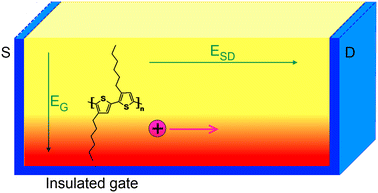Electric field dependence of charge mobility in linear conjugated polymersPetr Toman, Miroslav Menšík, and Jiří Pfleger Academy of Sciences of the Czech Republic, v.v.i., Prague 6, Czech Republic
E-mail: toman@imc.cas.cz Abstract: A combined quantum mechanical and semi-classical approach was used for the description of the charge carrier transport, taking into account realistic microscopic lamellar structure present in many common conjugated polymers. Unlike previous theoretical models that consider a polymer as a 3D point lattice of single-state sites or model the polymer chain as a molecule with single charge state, our molecular-scale model takes into account the density of states of conjugated polymer chain segments determined using a quantum–mechanical tight-binding model. Because of the relatively fast charge carrier delocalization on the conjugated polymer chain segments, the short-distance on-chain motion is separated from the slower inter-chain hopping. Inter-chain hopping rates, described by means of the Marcus theory, are calculated self-consistently with the chain segment occupation. The present model describes the electric field dependence of the hole mobility in conjugated polymers and includes the influence of the transverse electric field, which is important for simulation of the gate-voltage dependences of the charge carrier transport in organic field effect transistors. Keywords: Charge carrier mobility ; Electric field dependence ; Conjugated polymer ; Charge transport modelling ; Field effect transistor Full paper is available at www.springerlink.com. DOI: 10.1007/s11696-018-0448-0
Chemical Papers 72 (7) 1719–1728 (2018) |
Thursday, April 03, 2025 |
|||
© 2025 Chemical Papers |
||||






